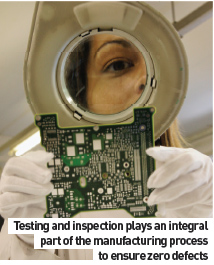Garry Myatt of Exception PCB takes a look at how saving weight and increasing durability in vehicle electronic architectures can draw lessons from race car technology developments
The quest to develop more powerful, yet lighter, electronics systems for the motor industry is one of the key areas of focus for manufacturers. And nowhere is this more important than in the competitive motorsport sector, where tenths of a second can make the difference between success and failure on the track.
 In practical terms, this challenge often falls at the feet of the printed circuit board industry, which is pushing forward the boundaries of reliability and performance. The challenge facing electronics engineers working in the fields of automotive, and more specifically motorsport, is to achieve that critical balance between performance and reliability. And nowhere is this tension more evidently played out than in the area of PCB design and manufacture. While wafer thin electronic components are hidden from view, their role is crucial in the smooth running of a commercial airliner, fighter jet, ruggedised tracked vehicle or the demanding requirements of F1 racing cars.
In practical terms, this challenge often falls at the feet of the printed circuit board industry, which is pushing forward the boundaries of reliability and performance. The challenge facing electronics engineers working in the fields of automotive, and more specifically motorsport, is to achieve that critical balance between performance and reliability. And nowhere is this tension more evidently played out than in the area of PCB design and manufacture. While wafer thin electronic components are hidden from view, their role is crucial in the smooth running of a commercial airliner, fighter jet, ruggedised tracked vehicle or the demanding requirements of F1 racing cars.
Heavy metal
Weight is perhaps the number one priority in terms of component selection when it comes to the autosport industry, where components are designed to come in below the minimum weight. The electronics infrastructure of modern performance cars plays a surprisingly influential role in the weight distribution debate.
The electronics system on a race car has sensors throughout the body, with wires traditionally bringing all of the information back to one point. This has significant a weight implication in terms of heavy wiring running across the vehicle. Now, design teams build networks of satellite processors across the bodywork, increasingly reducing the number of cable looms, which in turn reduces both weight and complexity.
The heat of battle
Despite their diminutive size, electronic components still generate a surprising amount of heat. The need to provide electronics with airflow cooling requires aerodynamic compromises (never popular) and limits the location of electronic systems around the body. If you can reduce temperature generation, fewer heatsinks need to be used, in turn reducing weight (always popular!).
In addition, there is a huge amount of vibration inside a high performance car, both internally from powerful engines and externally transmitted through the suspension system during a race. This vibration creates an incredibly hostile environment for fragile electronic components such as circuit boards and other hardware elements of the electronics system. Designing and manufacturing PCBs and satellite boxes to stand up to the vibration caused by racing is no mean feat. Destructive and non-destructive testing both play a vital part of the development process to ensure that critical elements of the monitoring and diagnostics systems do not fail when they are most needed. Generally, electronics systems and sensors are getting smarter, so more is expected of them. Today’s electronics systems are able to meet those challenges. Yet it’s a vicious circle – as the electronics get better, we demand more and we put more into the electronic control unit, which means it gets hotter, yet again.
So, electronics locations need to be carefully reconsidered in order to compensate for this knock-on effect. Clearly, continual investment in innovation and new ways of working to overcome design issues are what is needed. There are no simple answers when it comes to PCB design for the competitive autosport market – it’s a continual evolution that requires ongoing investment in product design and innovation.


































